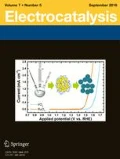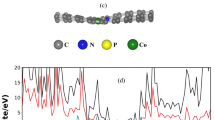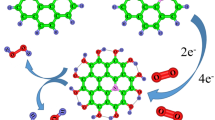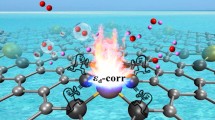Abstract
Two types of single metal atoms embedded in graphene were investigated as a potential electrocatalyst for oxygen reduction reaction (ORR) for the application in a fuel cell. ORR was considered in the four elementary reaction steps of oxygen hydrogenation, perhydroxyl production, atomic oxygen hydrogenation, and final water form. All calculations of catalytic activity were performed with the Vienna Ab Initio Simulation Package (VASP) on an M@Gra (M = Mn, Fe, Co, and Ir)–embedded structure, indicating that high-efficiency catalytic activity in the oxidation reaction takes place on the top of metal atom sites. Our calculations revealed that ORR is profiled via four-electron transfer pathway. Activity of these catalysts is closely related to the same scaling linear relations between the adsorption energies of the ORR intermediates on different catalytic surfaces; this can improve their catalytic activity for O2 reduction through a high-efficiency 4e reaction path. Mn- and Ir-doped of cell A graphene exhibited excellent ORR catalytic performance in case of their small overpotential (less than 0.23 V) and low-energy barrier (less than 0.64 eV) of the Ir-doped graphene rate-determining step. Mn@Gra and Fe@Gra of cell B monolayers showed poor ORR catalytic performance due to the strong interaction between various ORR-involved species. Based on the free energy change and activation energy of each intermediate reaction in ORR, Fe@Gra and Ir@Gra are promising catalysts for ORR processes in fuel cells. This provides useful guidance for different types of catalysts in applications to fuel cells.

Graphical Abstract







Similar content being viewed by others
References
M. Shao, Q. Chang, J.P. Dodelet, R. Chenitz, Recent advances in electrocatalysts for oxygen reduction reaction. Chem. Rev. 116(6), 3594–3657 (2016)
D. Deng, K.S. Novoselov, Q. Fu, N. Zheng, Z. Tian, X. Bao, Catalysis with two-dimensional materials and their heterostructures. Nat. Nanotechnol. 11(3), 218–230 (2016)
Y. Bing, H. Liu, L. Zhang, et al., Nanostructured Pt-alloy electrocatalysts for PEM fuel cell oxygen reduction reaction. Chem. Soc. Rev. 39(6), 2184–2202 (2010)
P. Strasser, S. Koh, T. Anniyev, J. Greeley, K. More, C. Yu, Z. Liu, S. Kaya, D. Nordlund, H. Ogasawara, M.F. Toney, A. Nilsson, Lattice-strain control of the activity in dealloyed core–shell fuel cell catalysts. Nat. Chem. 2(6), 454–460 (2010)
Y. Xiao, F.C. Zhang, J.I. Han, Synthesis, characterization and lithium-ion migration dynamics simulation of LiFe 1− x T x PO 4 (T= Mn, Co, La and Ce) doping cathode material for lithium-ion batteries. Appl. Phys. A 122(11), 980 (2016)
L. Yu, X. Pan, X. Cao, et al., Oxygen reduction reaction mechanism on nitrogen-doped graphene: a density functional theory study. J. Catal. 282(1), 183–190 (2011)
W. Sheng, H.A. Gasteiger, Y. Shao-Horn, Hydrogen oxidation and evolution reaction kinetics on platinum: acid vs alkaline electrolytes. J. Electrochem. Soc. 157(11), B1529–B1536 (2010)
A. Morozan et al., Catalytic activity of cobalt and iron phthalocyanines or porphyrins supported on different carbon nanotubes towards oxygen reduction reaction. Carbon 49(14), 4839–4847 (2011)
P. Zhao, Y. Su, Y. Zhang, et al., CO catalytic oxidation on iron-embedded hexagonal boron nitride sheet. Chem. Phys. Lett. 515(1–3), 159–162 (2011)
J. Greeley, I.E.L. Stephens, A.S. Bondarenko, et al., Alloys of platinum and early transition metals as oxygen reduction electrocatalysts. Nat. Chem. 1(7), 552–556 (2009)
B. Lim, M. Jiang, P.H.C. Camargo, et al., Pd-Pt bimetallic nanodendrites with high activity for oxygen reduction. Science 324(5932), 1302–1305 (2009)
M.H. Seo, S.M. Choi, H.J. Kim, et al., The graphene-supported Pd and Pt catalysts for highly active oxygen reduction reaction in an alkaline condition. Electrochem. Commun. 13(2), 182–185 (2011)
D. Kong, J.J. Cha, H. Wang, et al., First-row transition metal dichalcogenide catalysts for hydrogen evolution reaction. Energy Environ. Sci. 6(12), 3553–3558 (2013)
H. Wang, H. Feng, J. Li, Graphene and graphene-like layered transition metal dichalcogenides in energy conversion and storage. Small 10(11), 2165–2181 (2014)
Q. Xue, Z. Pei, Y. Huang, et al., Mn3O4 nanoparticles on layer-structured Ti3C2 MXene towards the oxygen reduction reaction and zinc–air batteries. J. Mater. Chem. A 5(39), 20818–20823 (2017)
S. Zhou, X. Yang, W. Pei, N. Liu, J. Zhao, Heterostructures of MXenes and N-doped graphene as highly active bifunctional electrocatalysts. Nanoscale 10(23), 10876–10883 (2018)
F. Calle-Vallejo, J.I. Martinez, J. Rossmeisl, Density functional studies of functionalized graphitic materials with late transition metals for oxygen reduction reactions. Phys. Chem. Chem. Phys. 13(34), 15639–15643 (2011)
H. Zhang, Y. Tian, J. Zhao, et al., Small dopants make big differences: enhanced electrocatalytic performance of MoS2 monolayer for oxygen reduction reaction (ORR) by N–and P–doping. Electrochim. Acta 225, 543–550 (2017)
S. Kattel, P. Atanassov, B. Kiefer, Catalytic activity of Co–N x/C electrocatalysts for oxygen reduction reaction: a density functional theory study. Phys. Chem. Chem. Phys. 15(1), 148–153 (2013)
C. Zhu, S. Fu, Q. Shi, D. du, Y. Lin, Single-atom electrocatalysts. Angew. Chem. Int. Ed. 56(45), 13944–13960 (2017)
X. Zhang, J. Guo, P. Guan, et al., Catalytically active single-atom niobium in graphitic layers. Nat. Commun. 4, 1924 (2013)
C. Montero-Ocampo, J.R.V. Garcia, E.A. Estrada, Comparison of TiO2 and TiO2-CNT as cathode catalyst supports for ORR[J]. Int. J. Electrochem. Sci 8, 12780–12800 (2013)
Y. Xiao, Y. Ding, H. Cheng, et al., The potential application of 2D Ti2CT2 (T=C, O and S) monolayer MXenes as anodes for Na-ion batteries: a theoretical study. Comput. Mater. Sci. 163, 267–277 (2019)
Y. Xiao, J. Wang, Y. Wang, et al., A new promising catalytic activity on blue phosphorene nitrogen doped nanosheets for the ORR as cathode in nonaqueous Li–air batteries. Appl. Surf. Sci. 488, 620–628 (2019)
K. Kumar, C. Canaff, J. Rousseau, et al., Effect of the oxide–carbon heterointerface on the activity of Co3O4/NRGO Nanocomposites toward ORR and OER[J]. J. Phys. Chem. C 120(15), 7949–7958 (2016)
S. Kattel, G. Wang, A density functional theory study of oxygen reduction reaction on M–N4 (M= Fe, Co, or Ni) clusters between graphitic pores. J. Mater. Chem. A 1(36), 10790–10797 (2013)
Y. Liu, H. Jiang, Y. Zhu, et al., Transition metals (Fe, Co, and Ni) encapsulated in nitrogen-doped carbon nanotubes as bi-functional catalysts for oxygen electrode reactions. J. Mater. Chem. A 4(5), 1694–1701 (2016)
H. Yin, C. Zhang, F. Liu, et al., Hybrid of iron nitride and nitrogen-doped graphene aerogel as synergistic catalyst for oxygen reduction reaction. Adv. Funct. Mater. 24(20), 2930–2937 (2014)
G. Fu, Z. Cui, Y. Chen, et al., Ni3Fe-N doped carbon sheets as a bifunctional electrocatalyst for air cathodes. Adv. Energy Mater. 7(1), 1601172 (2017)
M.D. Bhatt, G. Lee, J.S. Lee, Density functional theory (DFT) calculations for oxygen reduction reaction mechanisms on metal-, nitrogen-co-doped graphene (M-N2-G (M= Ti, Cu, Mo, Nb and Ru)) electrocatalysts. Electrochim. Acta 228, 619–627 (2017)
Y. Ito, H.J. Qiu, T. Fujita, Y. Tanabe, K. Tanigaki, M. Chen, Bicontinuous nanoporous N-doped graphene for the oxygen reduction reaction. Adv. Mater. 26(24), 4145–4150 (2014)
Y. Han, Y.G. Wang, W. Chen, R. Xu, L. Zheng, J. Zhang, J. Luo, R.A. Shen, Y. Zhu, W.C. Cheong, C. Chen, Q. Peng, D. Wang, Y. Li, Hollow N-doped carbon spheres with isolated cobalt single atomic sites: superior electrocatalysts for oxygen reduction. J. Am. Chem. Soc. 139(48), 17269–17272 (2017)
G. Kresse, J. Furthmüller, Software VASP, Vienna (1999). Phys. Rev. B 54(11), 169 (1996)
J. Hafner, Ab-initio simulations of materials using VASP: density-functional theory and beyond. J. Comput. Chem. 29(13), 2044–2078 (2008)
J.P. Perdew, K. Burke, M. Ernzerhof, Perdew, Burke, and Ernzerhof reply. Phys. Rev. Lett. 80(4), 891 (1998)
Z. Wu, R.E. Cohen, More accurate generalized gradient approximation for solids. Phys. Rev. B 73(23), 235116 (2006)
J. Moellmann, S. Grimme, DFT-D3 study of some molecular crystals. J. Phys. Chem. C 118(14), 7615–7621 (2014)
G. Henkelman, B.P. Uberuaga, H. Jónsson, A climbing image nudged elastic band method for finding saddle points and minimum energy paths. J. Chem. Phys. 113(22), 9901–9904 (2000)
R.R. Nazmutdinov, E. Santos, W. Schmickler, Spin effects in oxygen electrocatalysis: a discussion. Electrochem. Commun. 33, 14–17 (2013)
A.X. Yin, W.C. Liu, J. Ke, et al., Ru nanocrystals with shape-dependent surface-enhanced Raman spectra and catalytic properties: controlled synthesis and DFT calculations. J. Am. Chem. Soc. 134(50), 20479–20489 (2012)
Y. Xiao, F.C. Zhang, J.I. Han, Electrical structures, magnetic polaron and lithium ion dynamics in three transition metal doped LiFe1− xMxPO4 (M= Mn, Co and La) cathode material for Li ion batteries from density functional theory study. Solid State Ionics 294, 73–81 (2016)
C. Kirk, L.D. Chen, S. Siahrostami, M. Karamad, M. Bajdich, J. Voss, J.K. Nørskov, K. Chan, Theoretical investigations of the electrochemical reduction of CO on single metal atoms embedded in graphene. ACS Cent. Sci. 3(12), 1286–1293 (2017)
L. Feng, Y. Liu, J. Zhao, Iron-embedded boron nitride nanosheet as a promising electrocatalyst for the oxygen reduction reaction (ORR): a density functional theory (DFT) study. J. Power Sources 287, 431–438 (2015)
Guillory J K. Book Review of CRC Handbook of Chemistry and Physics. 2010
Y. Xiao, Y. Liu, N. Frederick, et al., Ab initio study of the electronic structure, magnetic and dynamics properties in LiMO2 and NaMO2 (M=V and Cr) as electrode cathode material for batteries. Solid State Ionics 307, 26–34 (2017) 2018, 122(51): 29307–29318
V. Wang, N. Xu, VASPKIT: A Pre- and Post-Processing Program for the VASP Code
Z. Lu, G. Xu, C. He, et al., Novel catalytic activity for oxygen reduction reaction on MnN4 embedded graphene: a dispersion-corrected density functional theory study[J]. Carbon 84, 500–508 (2015)
Acknowledgments
The Lichtenberg high-performance computer is gratefully acknowledged, and we are also thankful to TU Darmstadt. We also thank LetPub (www.letpub.com) for its linguistic assistance during the preparation of this manuscript.
Funding
Financial support comes from the China Scholarship Council (CSC:201808440416) of China, Research and the Arts (HMWK) of the Hessen state in Germany, and Natural Science of Foundation of Hubei Province, China (No. 2019CFB225).
Author information
Authors and Affiliations
Corresponding authors
Ethics declarations
Conflict of Interest
The authors declare that they have no conflict of interest.
Additional information
Publisher’s Note
Springer Nature remains neutral with regard to jurisdictional claims in published maps and institutional affiliations.
Electronic supplementary material
ESM 1
(DOC 2415 kb)
Rights and permissions
About this article
Cite this article
Xiao, Y., Zhang, W. High-Throughput Calculation Investigations on the Electrocatalytic Activity of Codoped Single Metal–Nitrogen Embedded in Graphene for ORR Mechanism. Electrocatalysis 11, 393–404 (2020). https://doi.org/10.1007/s12678-020-00598-8
Published:
Issue Date:
DOI: https://doi.org/10.1007/s12678-020-00598-8




